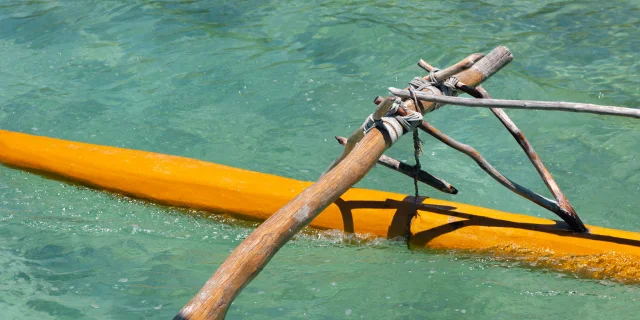Must-sees places
One of the Top 10 must visit in New Caledonia !
 default
defaultOne of the Top 10 must visit in New Caledonia !
Located north of the small island of Koutomo, southeast of the Isle of Pines, Upi Bay is often compared to Halong Bay in Vietnam. The comparison lies in the huge rocks on the water, which seem to float as if by magic. But here, all is quiet: only a few traditional pirogues bob quietly on the water. All you can hear is the gentle lapping of the water, a few birds, and the gentle breeze that caresses the sails and your face… The landscape of Upi Bay, with its pirogues, turquoise water and rocks, is one of New Caledonia’s most emblematic.
Located north of the small island of Koutomo, southeast of the Isle of Pines, Upi Bay is often compared to Halong Bay in Vietnam. The comparison lies in the huge rocks on the water, which seem to float as if by magic. But here, all is quiet: only a few traditional pirogues bob quietly on the water. All you can hear is the gentle lapping of the water, a few birds, and the gentle breeze that caresses the sails and your face… The landscape of Upi Bay, with its pirogues, turquoise water and rocks, is one of New Caledonia’s most emblematic.
 default
default Upi Bay Charlotte Bertonneau 6604
Upi Bay Charlotte Bertonneau 6604If there’s one must-do activity on the Isle of Pines, it’s a traditional pirogue trip in Upi Bay! Comprising a main hull carved from a log and a lightweight wooden outrigger, this sailing boat is the fruit of know-how handed down from generation to generation. Once used for timber transport and fishing, they are now used by visitors. The tour starts from the baie Saint-Joseph, for a two-hour crossing of wonder.
You can book your trip the day before though your accommodation or the provider
The crossing begins around 8-8:30 am, facing the splendid colours of the lagoon, with Pic N’Ga (the island’s highest peak) at your back. You’ll then head for Upi Bay! If the winds are favourable, your piroguier will hoist his sail right from the start. Keep your eyes wide open! The show is breathtaking. The coral rocks seem to balance above the water, in the middle of this bay surrounded by Araucaria pines trees. The turtles poke their heads out. If you’re lucky, you’ll even spot stingrays and dolphins. After around 1½ hours of walking, you’ll come alongside a small beach, the gateway to the forest leading you to the Baie d’Oro and the Natural Swimming Pool.
Most pirogue excursions combine the crossing with a visit to the natural pool. When the crossing is over, your piroguier will let you continue your excursion on foot (40 to 50 minutes) to reach the Baie d’Oro and the famous Natural Pool. Your hotel shuttle will pick you up at 3pm, not far from the Le Méridien hotel. Expect to pay 200 CFP francs to enter the natural swimming pool.
The second option is to book the return trip by traditional pirogue rather than continuing on to Baie d’Oro. In this case, chances are you’ll be alone on board, as most visitors choose the first option. You can then enjoy this enchanting place in perfect peace and quiet, and easily strike up a conversation with your piroguier. In all cases, you’ll need to book your outing with your accommodation the day before.
Traditional outrigger pirogues are the result of know-how handed down from generation to generation. Saint-Joseph Bay is still home to a small construction site where these emblematic New Caledonian boats are made the old-fashioned way.
Once made from araucaria (columnar pine), the more solid kohu is now used as a raw material. In terms of tools, the chainsaw has replaced the use of fire for felling, but the technique remains the same. The trunk is cut a few days after the full moon, when the sap sinks into the roots and the wood is less likely to rot. The trunk is then immersed in water for three weeks, before being dried with salt from the seawater. The lower part of the pirogue is hollowed out. It is sometimes enhanced with planks. The lateral balance ensures stability. The sail is made of canvas (for a long time it was woven from pandanus). Finally, a small motor has been added for windless days!
 Upi Bay Charlotte Bertonneau 6518
Upi Bay Charlotte Bertonneau 6518